
Welcome to the fourth post in my 5-part series about analyzing, understanding and utilizing the basics of Google Analytics. If you missed the first three posts in this series, you can catch up now by clicking these links:
- Google Analytics: The Basics
- Google Analytics: A Peek into Reports
- Google Analytics: Analyzing and Understanding the Audience Report
Google Analytics is a robust data mining service provided by Google for free. For bloggers who intend to derive revenue from their blog, it is an important tool to install on your blog. With the basic overviews and metrics Google Analytics provides at your fingertips, bloggers can better understand:
- what drives traffic to your site
- how traffic arrives on your site
- what changes to make to your blog to increase traffic to your site
The information provided by Google Analytics’ various reports is so diverse. But, some of the tools they provide do require a knowledge of code. So, if you are not familiar with HTML (and I’m not!), and you want to use those specific reports, you will need to hire someone who does know code or learn HTML yourself!
But, the beauty of Google Analytics’ reports is that you don’t need to use everything they offer in order to analyze data and determine what’s working on your blog. By learning to read and understand a few of their basic reports, bloggers can make huge strides in improving traffic to their site by tweaking various marketing strategies.
This post makes the following assumptions about you, the reader:
- The reader has a blog
- The reader’s blog is a business
- The reader has installed Google Analytics
- The reader has limited experience in using Google Analytics
When you first log on to Google Analytics, the left side of your screen is a navigation sidebar with drop-down menus. We have covered several of those navigation aids in the first three parts of this series and this post focuses on the Acquisition report.
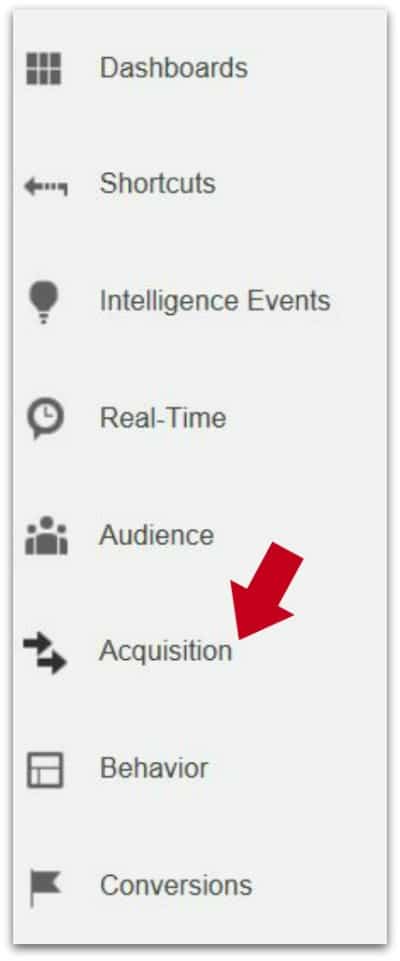
Acquisition
“Acquisition” is the term used to describe how visitors arrive on your site.
- Are they arriving via a key word search?
- Are they arriving directly by typing in your URL?
- Are they linking through from social media?
- Are they linking through from a reference link on another site?
- Or, are they arriving via feed readers?
Knowing these answers help bloggers plan marketing strategies for increasing traffic.
Once you click on the Acquisition report, it drops-down and provides many reports about “acquisition” or how visitors arrive on your site. The choices are:
- Overview
- Channels
- All Traffic
- All Referrals
- Campaigns
- Key Words
- Cost Analysis
- AdWords
- Social
- Search Engine Optimization
In addition, 4 of the choices above (Key Words, AdWords, Social and Search Engine Optimization) have their own additional drop-downs with even more ways to view and analyze data. And, many of these choices involve either enabling Webmaster Tools or setting up other parameters involving coding.
But, there is a wealth of information available to analyze without taking these additional steps. In this post, we will focus on those.
Acquisition Overview
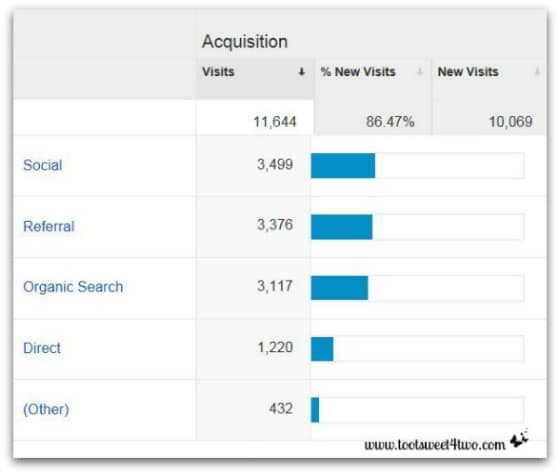
The Acquisition Overview (and Channels) is a quick look at where all traffic is coming from when landing on your site. The Channels report (no photo included) includes a line graph and a little more detail, such new versus returning visitors, bounce rate, etc.
As you can see in the photo above, the majority of my traffic comes from social network sites. However, referral traffic is not far behind and organic search is right up there, too. What does all of this mean?
Social – these are sites like Facebook, Twitter, Pinterest, Google+, Instagram, StumbleUpon, Tumblr, Reddit, Digg, etc.
Referral – these are sites that have links back to your site such as Creative Income blog, Fave Crafts, All Free Casserole Recipes, other blogs (could include linky parties, blog hops, guest posting), etc.
Organic Search – visitors land on your site based on the words they type in a search engine, for example: Peach Pineapple Dump Cake. That is a very specific key word search and there is a good chance that visitors will have a choice to click through to our site if they use that combination of words in their key word search.
Direct – this means that visitors are actually typing in the specific URL to land on a site; in this case, this means that visitors typed Toot Sweet 4 Two’s URL to land on our site.
Other – in our case, the “other” is RSS. That means that 432 visits to our site in the month of February came through RSS, a feed reader in which the visitor has subscribed.
The top 3 (social, referral, organic search) are very important to me because they indicate to me that we are doing a good job of “spreading the wealth”. It is important for blogs not to rely heavily on one area to drive traffic to their site. For example, what would happen if the majority of our social traffic arrived on our site from Facebook and they changed their algorithms? In a flash, that traffic could dry up.
So, by having your traffic arrive via referral and organic search, too, it creates a “safety net” of sorts so that when and if those types of events happen (and they will), you won’t have to start over from square one!
Having visitors arrive via Direct and Other (RSS, in our case) is exciting to me because that means those visitors have made a conscious decision to visit us PLUS they are the ones that will stay more than 10 seconds and explore our blog, read our current and old posts and increase the amount of overall time spent on our blog! We love our readers!
All Traffic and All Referrals
The “All Traffic” report and the “All Referrals” report are similar in structure in that they both include a line graph and then more specific information. Since we’ve pretty much discussed the “All Traffic” report in the “Acquisition Overview” above, we will focus on “All Referrals.”
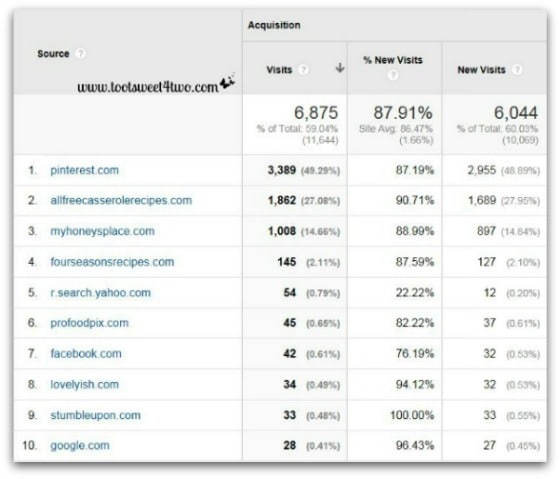
The majority of the traffic referred to my site comes from Pinterest, followed by All Free Casserole Recipes and My Honeys Place. What does this mean to us? This tells us that Pinterest is a key player in our traffic from both a referral and social network perspective. They are unique in that way.
So what does my report tell you? It tells you that I’m active on Pinterest, that I’ve developed a good relationship with All Free Casserole Recipes by continuing to develop new recipes that fit their demographic and readership. It also tells you that I have a similarly successful partnership with My Honeys Place.
As respects Four Seasons Recipes and Pro Food Pix, they are recipe content aggregators. They allow you, the blogger, to add a photo and minimal information to their site with a link back to your site (like Pinterest, in a way). As an experiment, I added one of my recipes in each site. I wanted to “test the waters” and see what would happen. Now I know that both are worthy of taking time to add my recipes to their sites because both will generate traffic to our site.
Key Words
Developing a “key word” strategy is a component of building your blog. However, it has become more difficult to analyze key words. Google has changed the way they display the key word report because of privacy issues. To me, since they now “suppress” the majority of this information, I no longer spend any time looking at this report. But, I wanted to bring it to your attention, plus address the fact that Google has made this change.
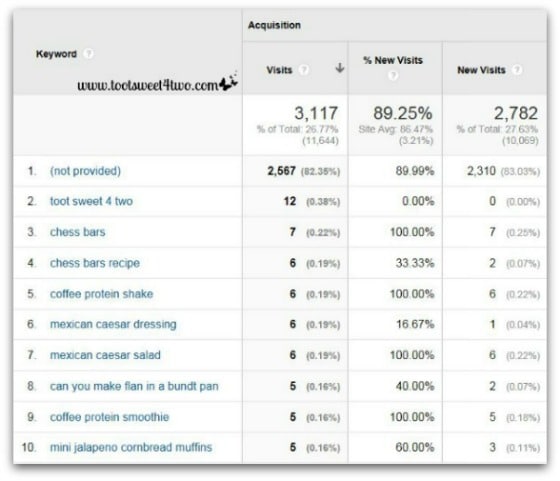
What you can tell is that Google is:
- not providing me with information on 2,567 key word searches
- that 12 people searched for the key words “toot sweet 4 two”
- and the rest are all recipe searches based on specific words.
Although still available, this report is of limited use. However, learning good search engine optimization (SEO) techniques is still a worthy investment of your time as a blogger.
Social
If social networking is a part of your blog growth strategy, then the “Social” report offers tremendous value and multiple opportunities for analyzing data. By clicking on “Social”, it drops-down to include the following additional report choices:
- Overview
- Network Referrals
- Data Hub Activity
- Landing Pages
- Trackbacks
- Conversions
- Plugins
- Visitors Flow
Each of these areas is worthy of exploration. But, to limit the length and scope of this article (because all are very broad topics), let’s review “Visitors Flow.”
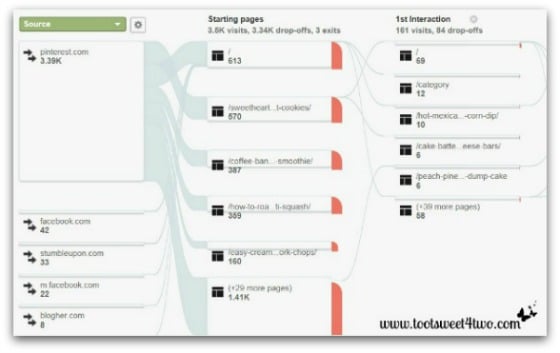
In the photo above, you can see where traffic is coming from and where they are going once they arrive. Are they leaving? Yes, a great deal are. But, others stay and look at other posts. This “flow” can help bloggers understand what content is generating interest and what content makes them stay. And, as bloggers, we all want them to stay, don’t we?
Stay tuned for the last part of the series…Google Analytics: Analyzing the Behavior Report!
Tootles,

Related Posts:
(other posts about blogging)
- 17 Girls and a Baby
- 1000 Hats
- A Fresh Start on a Budget
- Bloggy Boot Camp Revealed
- Breaking the Rules
- How to Make a Horizontal Photo a Pinterest-friendly Vertical Photo in PicMonkey
- Millennial Blogs: An Interview with Chelsea Day
- New Year, New View
- Nothing Ventured, Nothing Gained
- Really? Seriously? Are You Frickin’ Kidding Me?
- Someday I’ll Learn
- The Conference Hangover
- The Red Plate Goes to Julie Washington
- Toot Sweet 4 Two Turns One: Blog-o-versary Party Recap
- Top 10 Reasons Why I Love Bloggy Boot Camp
- Under Construction
- We Heart the Snipping Tool
Leave a Reply